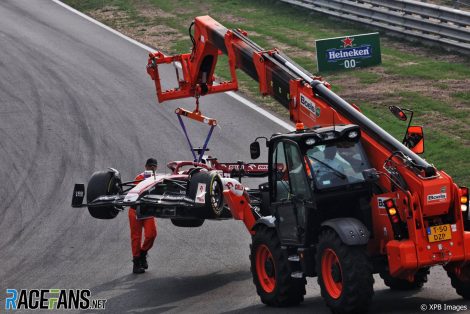The FIA Formula 1 race director has three choices of how to neutralise erase: red flag, Safety Car, or Virtual Safety Car. On lap 43 of the Dutch Grand Prix, a VSC was the worst of those options for Mercedes, as it allowed the driver they were chasing to make a pit stop without closing the field up afterwards.
At first, it seemed that VSC had decided the destiny of the Dutch Grand Prix. When Yuki Tsunoda’s AlphaTauri came to a permanent stop by the side of the track, the VSC was used to enable the car’s safe recovery, and therby handed race leader Max Verstappen the opportunity to pit his Rrd Bull team had been waiting for. Lewis Hamilton and George Russell were closing in but the VSC meant Verstappen could now make his second and final pit stop without falling behind them.
The only good news for Mercedes was they had enough of a gap over Charles Leclerc’s Ferrari to be able to bring both their drivers in as well. The trio therefore resumed the race with Verstappen still leading, now on hard tyres, and the pursuing Mercedes pair on mediums.
Mercedes team principal Toto Wolff later said their simulations indicated that without the VSC, Verstappen would have come out of the pits on hard tyres and only caught Hamilton with six laps to go. That drama never unfolded, but another interruption to the race seemed to hand Mercedes a chance to claim that victory.
Race control were able to move to Tsunoda’s car out of the way using the lesser disruption of a VSC because he had stopped close to a gap in a barrier that his car could be pushed into. However when Valtteri Bottas came to a stop at the beginning of his 54th lap there was no such nearby opening. He parked his Alfa Romeo on the inside line approaching Tarzan. That made the recovery process more complicated, which meant a full Safety Car was needed.
The race would therefore resume with the cars in a tight queue, the former gaps between them eradicated, unlike after a VSC. Most teams had been reluctant to use the hard tyre before the race began, and Red Bull were surprised Mercedes were able to make it work as well as they did, so it is no surprise the leaders didn’t want to leave Verstappen out at the front of the field on a set of hard tyres for a rolling restart with 16 or so laps remaining.
Red Bull therefore pitted Verstappen for a used set of soft tyres, accepting that doing so would drop him behind the two Mercedes drivers. To begin with,…
Click Here to Read the Full Original Article at RaceFans…

